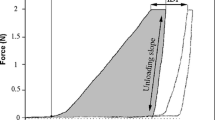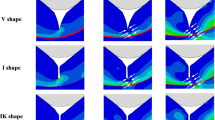Abstract
The objective of this study was to determine the geometric characteristics associated with the critical crack caused by cyclic loading. In an attempt to simulate an intraoral loading condition, the Hertzian cyclic loading of baria–silicate glass was performed using a type 302 stainless steel indenter under an aqueous environment using clinically relevant parameters, i.e., a low loading frequency (∼3 Hz) and a low load level (≤200 N). The indenter diameter (4.76 mm) approximated the cuspal radii of molar and premolar teeth. Ten bar specimens each were subjected to loading cycles of 0, 103, 104, and 105 cycles. A four-point bending test was used to quantify the severity of the strength reduction caused by the repeated loading test. There was a decrease in fracture stress after 103 cycles that was associated with cone crack formation. No significant additional reduction was found after 105 cycles for specimens tested both in air and in deionized water. Stress-corrosion fatigue accelerated the surface crack propagation rate in baria–silicate glass specimens. Four different crack geometries were identified along with failure mechanisms. Various fracture mechanics approaches were tested against observed crack geometries. The previously unobserved triangular crack geometry was found.













Similar content being viewed by others
References
J.N. Walton, F.M. Gardner, and J.R. Agar: A survey of crown and fixed partial denture failures: Length of service and reasons for replacement. J. Prosthet. Dent. 56, 416 (1986).
L.V. Foster: Failed conventional bridge work from general dental practice: Clinical aspects and treatment needs 142 cases. Br. Dent.J. 168, 199 (1990).
J.P. Moffa, A.A. Lugassy, and J.A. Ellison: Clinical evaluation of a castable ceramic material. J. Dent. Res. 67, 118 (1988, abstract).
K.J. Anusavice: Phillip’s Science of Dental Materials, 10th ed. (W.B. Saunders Company, Philadelphia, PA, 1996). p. 63.
I.M. Peterson, S. Wuttiphan, B.R. Lawn, and K. Chyung: Role of microstructure on contact damage and strength degradation of micaceous glass-ceramics. Dent. Mater. 14, 80 (1998).
I.M. Peterson, A. Parjares, B.R. Lawn, V.P. Thompson, and E.D. Rekow: Mechanical characterization of dental ceramics by Hertzian contacts. J. Dent. Res. 77, 589 (1998).
H. Cai, M.S. Kalceff, B.M. Hooks, and B.R. Lawn: Cyclic fatigue of a mica-containing glass-ceramics at Hertzian contacts. J. Mater. Res. 9, 2654 (1994).
B.R. Lawn, N.P. Padture, F. Guiberteau, and H. Cai: A model for microcrack initiation and propagation beneath Hertzian contacts in polycrystalline ceramics. Acta Met. Mater. 42, 1683 (1994).
B.R. Lawn: Indentation of ceramics with spheres: A century after Hertz. J. Am. Ceram. Soc. 81, 1977 (1998).
F.C. Roesler: Brittle fractures near equilibrium. Proc. Phys. Soc. (London) B69, 981 (1956).
B.R. Lawn: Fracture of Brittle Solids (Cambridge University Press, Cambridge, UK, 1993). pp. 981–992.
B.R. Lawn, S.M. Wiederhorn, and H.H. Johnson: Strength degradation of brittle surfaces: Blunt indenters. J. Am. Ceram. Soc. 58, 428 (1975).
A.G. Evans: Strength degradation by projectile impacts. J. Am. Ceram. Soc. 56, 405 (1973).
Y. Murakami: Analysis of stress intensity factors of mode I, II and III for inclined surface cracks of arbitrary shape. Eng. Fract. Mech. 22, 101 (1985).
S.W. Freiman, G.Y. Onoda, and A.G. Pincus: Mechanical properties of 3BaO-5SiO2 glass. J. Am. Ceram. Soc. 57, 8 (1974).
G.R. Irwin: Crack-extension force for a part-through crack in a plate. J. Appl. Mech. 29, 651 (1962).
S.W. Freiman, A.C. Gonzales, and J.J. Mecholsky: Mixed mode fracture in soda lime glass. J. Am. Ceram. Soc. 62, 206 (1979).
T.J. Hill, J.J. Mecholsky, and K.J. Anusavice: Fracture toughness versus crystallization in baria–silicate glass-ceramics. Abstract 1657, Am. Assoc. Dent. Res. (1995).
S. Widjaja, J.E. Ritter, and K. Jakus: Influence of R-curve behavior on strength degradation due to Hertzian indentation. J. Mater. Sci. 31, 2379 (1996).
R.W. Hertzberg: Deformation and Fracture Mechanics of Engineering Materials, 4th ed. (John Wiley & Sons, Inc., New York, 1995). pp. 326–327.
Y. Zhang, S. Bhowmick, and B.R. Lawn: Competing fracture modes in brittle materials subject to concentrated cyclic loading in liquid environment. Monoliths.J. Mater. Res. 20, 2021 (2005).
Acknowledgments
This study was supported by National Institutes of Health-National Institute of Dental and Craniofacial Research (NIH-NIDCR) Grant DE06672 and the Royal Thai Government.
Author information
Authors and Affiliations
Corresponding author
Rights and permissions
About this article
Cite this article
Suputtamongkol, K., Anusavice, K.J. & Mecholsky, J.J. Fracture mechanics analysis of crack shapes due to cyclic loading in baria–silicate glass. Journal of Materials Research 22, 3415–3422 (2007). https://doi.org/10.1557/JMR.2007.0430
Received:
Accepted:
Published:
Issue Date:
DOI: https://doi.org/10.1557/JMR.2007.0430




